Contributory members are able to log private notes and comments about each site
Sites Anne T has logged. View this log as a table or view the most recent logs from everyone
Middleton Crosses
Date Added: 13th Oct 2014
Site Type: Ancient Cross
Country: England (Yorkshire (North))
Visited: Yes on 10th Oct 2014. My rating: Condition 3 Access 5
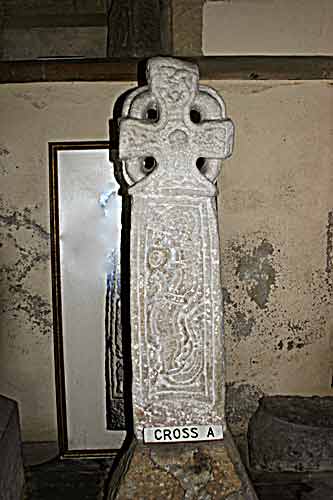
Middleton Crosses submitted by kelpie on 6th Mar 2004. These five Viking crosses are housed in Middleton Church (SE 78193 85438).
Cross A is a Jellinge type cross and shows a hunter with spear and scramasax, the other side shows a serpent type of animal.
(View photo, vote or add a comment)
Log Text: Middleton Crosses, St. Andrew’s Church, Church Lane, Middleton, North Yorkshire: From St. Gregory’s Minster, the A170 took us right through Middleton, and it was easy to spot the church on the left hand side of the road. I’d tried to phone beforehand to check if the church was open during the day, but the number published on the ‘achurchnearyou’ website was for a private house; I sent an email to Reverend Stephen Gamble but didn’t receive a reply until we were actually inside the church, saying the church is usually left open during the day.
Turning into Church Lane, it is long and narrow. There was just room to bump the car up onto the kerb opposite a gateway to a farm. At first glance, this church looks modern and not particularly interesting, but the more we looked, the more ancient and interesting the building became.
Apart from the crosses (crosses A and B kept against the base of the tower on the west wall, C, D and E kept in the north transept). It’s a shame that the area that C, D and E are kept in is used for general storage (we had to clamber over stacked chairs and other items) as it did spoil the ambience a little. Crosses A and B had clearly been whitewashed at some point in their lives, which made them look somewhat ‘unreal’.
The south entrance door has a wonderful 13th century trefoil and the door itself is from the 15th century (much repaired internally). The north aisle and tower date from the 12th and 13th centuries, although the base of the tower is Saxon. In the west wall, there is a blocked up doorway from the 11th century with an 8th century cross head and part of a shaft above it (we didn’t find the one in the south wall of the nave, as described on the visitor boards inside the church).
There is a sundial above the entrance to the porch, and an interesting ‘vow cross’, similar to the one at Escomb on a pillar in the north aisle.
Notes from the hand-held boards in the church:
The Crosses: The crosses and fragments in the North Aisle have been dated to the 10th century, perhaps related to the Viking kingdom of York c 876 to 954 AD. Cross A and Cross B are described as Jellinge crosses, after the cross of a similar type at Jellinge in Denmark. The stone types are all of a kind found on the North Yorkshire moors.
Cross A:A ring-head cross, typical of the area, depicts a hunter with spear, sword, shield and scramasax (a short sword), two dogs and a stag. On the reverse is a ‘Jellinge’ animal. The crossed has formerly been built into the tower, and was first recorded in 1911 and was removed in 1948.
Cross B: Depicts a warrior with a pointed helmet, spear, swod, shield, axe and scramasax. Again, on the reverse can be seen a ‘Jellinge’ animal. This cross also was discovered in the tower wall and ‘liberated’ in 1948. Celtic influences are mixed with Anglo-Scandinavian work, and it is supposed, by reason of the local stone (some is exposed 2km north of the church) and inferior workmanship, to be local in origin.
Cross C: First recorded at the east end of this aisle, in 1907, and is interesting in that it seems to combine both pagan, animal heads and a degenerate form of Christian vine scroll. It is unlike the others here, and has some Irish influences on an Anglian design, possibly representing an Anglian ‘Revival’.
Cross D:A fragment showing a warrior’s helmeted head, together with forked beard. A similar beard appears on the Kirkdale crucifix, although the example here is much cruder. A knife is slung from his belt, and a scramasax is to the right of his legs. This is very similar to Cross B, and it is thought that the same template was used. The contoured plait is unusual for this area.
Cross E:Formed of two fragments. The top part is a part of a ring-head cross. The bottom part has the head and shoulders of a man with a pointed helmet. The two fragments may have belonged together originally, but it is not possible to be sure.
There is another cross-head and shaft still built into the tower on the south wall against the nave wall. One arm of the cross has been dressed off, in order to use the monument as a quoin, but it seems that the full length survives."
Kirkdale Sundial
Date Added: 13th Oct 2014
Site Type: Early Christian Sculptured Stone
Country: England (Yorkshire (North))
Visited: Yes on 10th Oct 2014. My rating: Condition 4 Ambience 5 Access 5
Kirkdale Sundial submitted by Thorgrim on 20th Jan 2006. Sundial on the wall of St Gregory's Minster. (cast in the Science Museum, London)... The inscription reads: "This is the day's sun-marking at every hour. And Hawaro made me, and Brand, priest" . The lines with cross bars correspond to 6am, 9am, noon, 3pm and 6pm. The uncrossed lines divide time into one and a half hour periods. The line with a cross on it on the lefthand side of the dial denotes 7.30am which marked the brginning of "daytime". (N and M Kerr's Guide to Anglo-Saxon Sites)
(View photo, vote or add a comment)
Log Text: Anglo Saxon Crosses, St. Gregory’s Minster, Kirkdale, North Yorkshire (Kirkdale Sundial): Because the Corpus of Anglo Saxon Sculpture catalogue for Yorkshire cost £145, and my budget won’t currently run to buying it (!) I typed in ‘Anglo Saxon Sculptures’ into the internet and the search came up with both St. Gregory’s Minster and St. Andrew’s at Middleton. Good choice, Google! Thank you.
We arrived just after 11 o’clock to find two other cars in the car park. It turned out that one belonged to a florist setting up flowers for a wedding in the church that afternoon (she also said there was another wedding tomorrow, but they didn’t want to share the flowers) and one belonging to an elderly gentleman who, as we watched, hung his jacket on the church gate and picked up a brush and rake. He greeted us and asked us if we were going into the church and if we’d been before. On answering ‘no’, he told us to be careful of the step down into the church.
St. Gregory’s Minster is in a beautiful location, and is an even more beautiful building. It is clearly ancient and sits easily within the landscape.
The sundial above the main door into the church is breathtaking in its completeness. There are “Early Medieval carved stones built into the church include two early 9th century crosses; an early 10th century shaft/ slab fragment and a worn piece of late 9th century interlacing. Two grave slabs, early 8th century and 11th century two cross heads and a 10th-11th century shaft fragment are kept inside the church”.
Because there were so many flowers around the church, it was difficult to get a good photo of the cross heads inside the church. But outside it was spectacular and I was surprised to find only one other family wandering around looking at the fabric of the church, but not the cross-shafts.
By the time we’d finished wandering around the outside, there were many people coming in and out of the church and wandering around the churchyard. The car park was completely full, so we were glad we’d arrived earlier. The gentleman who’d greeted us on arrival caught us in the churchyard as we were going out. He told us that there had been ‘ladies’ who’d been round and told them they weren’t allowed to mow the back part of the churchyard, as there were over 80 (he spelled out ‘eight-oh’ to emphasise his point) species of wild flower. Walking back up the path with us, he asked if we’d enjoyed our visit, and I replied ‘very much so’. He said that people saying that made keeping the church tidy and clean worth while.
I felt very welcome at this hugely historic church and would go again to spend time and sit when it’s not so busy.
The Dragon Stone
Date Added: 12th Oct 2014
Site Type: Early Christian Sculptured Stone
Country: England (Yorkshire (North))
Visited: Yes on 10th Oct 2014. My rating: Condition 3 Access 5

The Dragon Stone, Levisham submitted by Sunny100 on 1st Jun 2010. The Dragon Stone at Levisham, N.Yorkshire, at SE.832907.
(View photo, vote or add a comment)
Log Text: The Dragon Stone, St John The Baptist, Levisham: The last time I was in Levisham was on a sunny but extremely cold January morning, when our department went on a ‘team building exercise’ – 7½ miles on a circular walk followed by lunch at The Horseshoe Inn. We stopped half way round the walk for a break and our guide told us we were sitting next to some ancient land boundaries but wasn’t knowledgeable to tell us what to look for, and no-one at the time was sufficiently interested to ask, as we had an hour to race back to The Horseshoe Inn for our pre-booked lunch. Shame.
Having stopped of in Kirkdale and Middleton on our way over to Levisham we had planned to stop off in Pickering for lunch, but arrived at the start of a ‘war re-enactment weekend’; almost everyone was in 1940s clothing or uniform – hundreds and hundreds of people. We felt out of place, and there was certainly no-where to park so we went into Malton.
Driving back to Levisham through Lockton, I recognised the scenery, but had no memory of the steep climb up to the village. Levisham is such a tiny village, built along both sides of a wide street. On my last visit, I hadn’t even noticed the tiny chapel tucked away at the road junction near the pub. This time, the whole of the street was lined with ‘no parking’ cones and large notices saying ‘no parking for the war time event’ (even though Levisham station was a good mile and a half away).
St John The Baptist is left open during the day (it has a 'church open' notice next to the door). It looked and felt very much like a Methodist church. The Dragon Stone is tucked right up against the north wall of the church, wedged between the pulpit and a storage heater at its east end and a pew at the west end. During our visit, there was a large stand of flowers over the stone, which we carefully had to slide out of shot (but only just as it was so heavy) and replace before we left.
There is a laminated sheet with a description of the stone on the window-ledge above it: “The Levisham Dragon Stone: This grave slab is decorated in the Viking Age style known as Mammen, which suggests a dating of the late 10th or early 11th century. The writhing beast carved onit is clearly derived from Norse pagan legends. But is it a dragon or a serpent – possibly Migarösorms (The World Serpent) – or something idiosyncratic? One theory is that it is a dedication to someone called Ormr, signifying ‘worm’ or ‘serpent’, a common name among the Vikings or their descendents. If so, Ormr, almost certainly a Christian convert, is represented here. The modern surname Hornsby, a derivation of Ormabyr, meaning Orm’s farm or settlement can be traced to this area.
The Dragon Stone was found in the vicinity of the old Levisham parish church of St. Mary, where it must have been lying for over a thousand years. It has been known to archaeologists since at least 1927, when it figures in a book by W.G. Collingwood. At some point it was brought up to the village to be housed in the present church. Information supplied by the University of Hull, 2009.”
All Saints (Helmsley)
Date Added: 11th Oct 2014
Site Type: Early Christian Sculptured Stone
Country: England (Yorkshire (North))
Visited: Yes on 10th Oct 2014. My rating: Condition 2 Ambience 2 Access 5
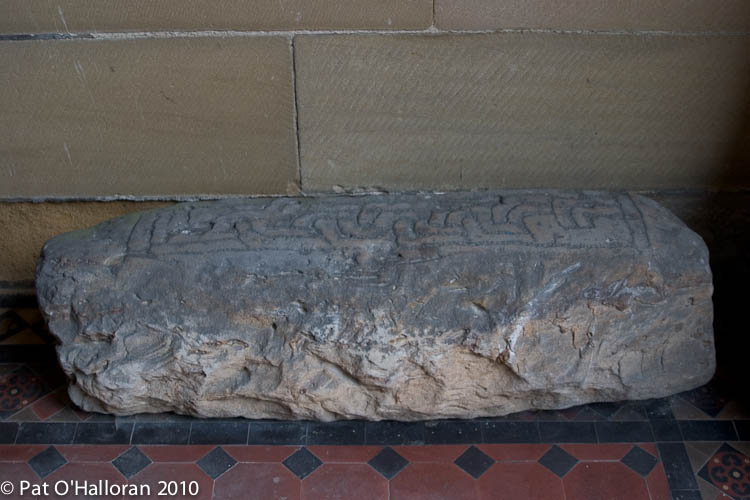
All Saints (Helmsley) submitted by kelpie on 2nd Apr 2011. The hogsback stone in the porch of the church
(View photo, vote or add a comment)
Log Text: All Saints (Helmsley) (Hogback Tomb Remanant): We last visited Helmsley on 19th August 2010 (was it really so long ago?) as we’d heard a lot about this attractive little town but never been. There was an event on at the castle and the place was totally overrun with tourists. After a cup of tea and a visit to the church, we escaped gratefully.
This time, it was very different. It was half past four and the town was quiet. The church is open until 5pm, so we went in search of the hogback fragment in the porch.
It sits on its own on the east wall of the porch, tucked away as an almost forgotten remnant behind the gates to the porch. At first, it’s almost not recognisable as a hogback, particularly as the simple rectangular interlaced pattern was so reminiscent of the Anglo Saxon cross shaft we’d seen built into the wall at St. Gregory’s Minster earlier today. The stone looks as if it has been completely hacked about and is now a ragged rectangular shape. I had to come back and read my ‘Grammar of Anglo-Saxon Ornament’ by Rosemary Cramp to see what shape it might have been to start with.
For anyone planning to visit the church, the wall paintings, whilst modern, are impressive. It has a lovely atmosphere and there are various stations around the church were candles are burning in remembrance.
There was no guide book, but I have an address to send away for one, and there is quite a bit of history about the church on the Helmsley Parish web site.
Low Dinsdale Cross
Date Added: 8th Oct 2014
Site Type: Ancient Cross
Country: England (County Durham)
Visited: Yes on 5th Oct 2014. My rating: Condition 4 Ambience 4 Access 5

Low Dinsdale Cross submitted by Anne T on 7th Oct 2014. The lower half of this Anglo Saxon cross shaft sits near the west end of the tower, near a large stone pre-conquest stone coffin.
(View photo, vote or add a comment)
Log Text: I found details of this beautiful little church on the Darlington Borough Council Website, under their Scheduled Monuments list.
Low Dinsdale is situated in a bend of the River Tees south east of Darlington. The church was originally built of pink sandstone, with modern work in red sandstone, which gives it a warm, welcoming appearance. The history sheet published by the church says that “Dinsdale Church was built in the year AD 638 ... the building consisted of a sanctuary, chancel and one long aisle.”
The church of St. John the Baptist sits on an ancient site and houses fragments of pre-Conquest sculptured stones, including two cross-heads, the lower part of a cross-shaft, and half of a hog-back stone. The lower part of the cross-shaft sits in the churchyard, near an impressively large pre-conquest stone coffin.
At the time of our visit, the eastern wall of the porch which houses the Anglo Saxon cross fragments had been taken down in preparation for the building of a toilet. The fragments currently sit on pews inside the church, which is kept locked. The church warden lives locally and an appointment to view can be arranged by telephoning in advance.
In conversation with the church warden, he told me that attendance at services runs to 8 or 9 people.
The church warden helped me to turn the stones around to see the carvings. On one fragment, two horsemen on side that had previously been mortared into the porch wall.
They had found some bones and had an archaeologist (who had been to Bosnia for war grave forensic identification) come and examine the bones and tell them what illnesses these people had. He thought they were from Newcastle University.
St. Mary's Well (Gainford)
Date Added: 8th Oct 2014
Site Type: Holy Well or Sacred Spring
Country: England (County Durham)
Visited: Yes on 5th Oct 2014. My rating: Condition 3 Ambience 3 Access 4
St. Mary's Well (Gainford) submitted by HOLYWELL on 11th Jan 2011. The area around the well whose never failing water fills the trough.
(View photo, vote or add a comment)
Log Text: St. Mary's Well, Gainford, North Yorkshire: OK, it was fairly dark by the time we arrived here. But when you’ve had a great day out, I’m always reluctant to call an end to it. From Stanwick with it's Viking and Saxon cross fragments, we had to pass through Gainford to get home anyway, but having read how picturesque it was and having seen photographs on the internet, I was surprised to see the main road cutting through it. However, turning right off the main road towards the picturesque village green, the images changed into a pretty, pretty village, and St Mary’s church came into view. It was dusk, and I had the camera on ‘sunset’ settings. Even so, the photograph of the church came out very ‘blue’ tinted. There were still plenty of dog walkers around, coming back from the river side walk. Coming out of the river side of the church yard, there was a path leading down to a little dell at the right hand side. There was St. Mary’s Well – a very pretty spot. In the depths of the trees overhanging the well, it was very dark indeed, and I turned on the flash on the camera. All of a sudden, a voice cut through the gloom: “The fairies are there in the morning you know!” Laughing, I nearly fell into the outflow from the well to find a lady dog walker staring down at us. “I know, we’re just a bit late”, I replied. At this point, it was too dark for even the camera to focus, so we beat a hasty retreat back home. As we’re planning on coming back to Forcett (St. Cuthbert’s) in a few weeks, we might call again to see this well in the daylight, and to take in the other (sulphurous well) elsewhere in the village.
Birtley Iona Cross
Date Added: 7th Oct 2014
Site Type: Ancient Cross
Country: England (Northumberland)
Visited: Yes on 2nd Oct 2014. My rating: Condition 4 Ambience 4 Access 5
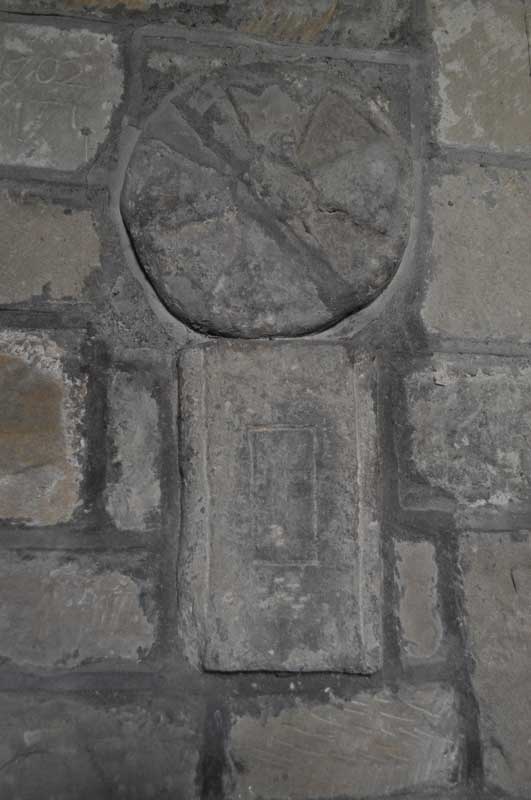
Birtley Iona Cross submitted by Anne T on 6th Oct 2014. An undated Saxon cross-shaft fragment and circular grave marker/dedication cross from the second half of the 11th century are built into the northern wall of the nave near the font.
(View photo, vote or add a comment)
Log Text: Iona Cross, Birtley (St. Giles, Birtley): From St. Giles in Chollerton, this church is easy to find, being only 6 miles away. To reach it, drive down the small road to the left hand side of the church and continue on down through Barrasford, turning right just before reaching the village of Wark (signpost says Birtley is 2 miles). The church is then on your right hand side as you enter the village. It sits with it’s narrowest (west side) next to the road and is hidden under trees, so it’s only when I saw the grave yard that I realised I’d arrived. I drove up into the village to turn around (been here for a walk years ago and parked at the top end of the village) and bumped up onto the pavement to park by the gate to the church.
The present church was rebuilt in the 18th century and renovated in the 19th century, and has a wonderful feel the minute you step through the door.
Opening the porch, there are grave covers built into the wall, and glorious flower arrangements left to welcome visitors as you enter.
Rev. Slade had told me about the Iona cross before my visit, so I left this until last to find. Three of the fragments are built into the north wall (two of them together, these near the font). The Iona cross is in the chancel. The fourth was high up on a ledge in the porch (I would have missed this had I not looked a third time to find it – didn’t think to look up).
Chollerton Cross
Date Added: 7th Oct 2014
Site Type: Ancient Cross
Country: England (Northumberland)
Visited: Yes on 2nd Oct 2014. My rating: Condition 4 Ambience 4 Access 5
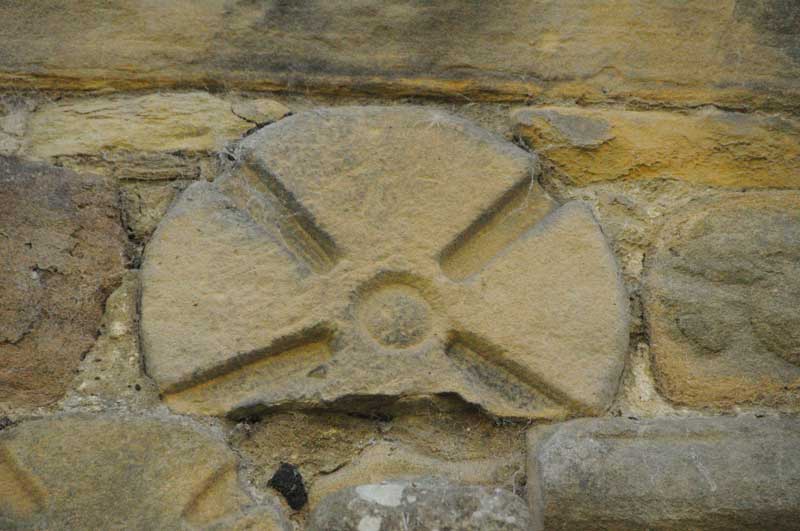
Chollerton Cross submitted by Anne T on 6th Oct 2014. Close up of 'Chollerton 02', part of a cross-head (reference from the Corpus of Anglo Saxon Stone Sculpture).
(View photo, vote or add a comment)
Log Text: Chollerton Cross (St. Giles, Saxon Crosses, Chollerton): It being the most beautiful sunny day with blue skies (but a frosty start), it was a perfect autumn afternoon. Last night I looked through the Anglo Saxon Corpus database and picked out some places within easy reach of my house.
My husband and I have been to St. Giles before, on 30th August 2007, but to look at the Roman features incorporated into the church and I had the tiniest little camera which took appalling photographs!
The tower was completely scaffolded and three or four men were working at the top of it in the sunshine. Parking by the old mortuary building, as I was changing lenses on my camera an elderly lady came across the road. She said she was waiting for the bus to come down and told me how she and her brothers and sisters used to come and clean the church when they were young; her father had changed the altar cloths and put everything ready for communion. She also told me how lucky they were to have someone as nice as Rev. Slade.
I found the Anglo-Saxon crosses on the north wall of the nave easily enough. On opening the door to the porch, there was part of another Saxon cross built into the wall above the door to the church.
The sun was so strong it was difficult to get a shot of the church without overexposing the shot, even at 1/4000th of a second.
In the guide book, a pretty child’s grave cover is described as sitting next to an 18th century sundial. I found the sundial, but next to it was a bucket of stone fragments. Despite walking twice round the church, I was unable to find this grave cover, so assume it’s either been broken or moved. I was touched by a pair of slippers kept by the font!
The guide book says that the church is Grade 1 listed, sited at the southern most end of Chollerton parish, was consecrated in 1097 and is the “mother church” of the parish. The name Chollerton derives from Anglo Saxon (Cholverton, Cholreton, Cholveriton).
The guide goes onto say the original church was probably wooden, with the stone church built around 1260 by William de Swinburne a Scottish knight (presumably there are links between his family and Swinburn Castle, with its standing stone) not far away. Part of the 12th century remains in the west walls between the nave and the tower tower and Roman piers have been used to create the south arcade.
There is a Roman font inside, dedicated to Jupiter, which has been inverted and modified for use today, although a more modern (13th century!) font with a Jacobean lid is in use today.
There is parking for two cars next to the old stable and hearse house with its mounting block, and it is possible to get a wheelchair up to the church (although not around to the north wall of the chancel to see the Saxon stones).
The Anker's House
Date Added: 2nd Oct 2014
Site Type: Ancient Cross
Country: England (County Durham)
Visited: Yes on 25th Sep 2014. My rating: Condition 4 Ambience 5 Access 5
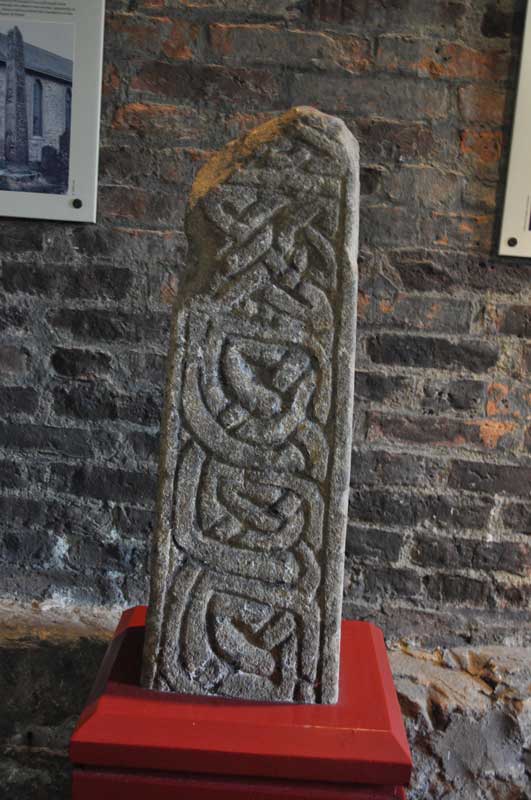
The Anker's House submitted by Anne T on 30th Sep 2014. Upper part of cross-shaft from the first half of tenth century.
Anglo-Saxon Stone Sculpture reference = Chester-le-Street 02.
(View photo, vote or add a comment)
Log Text: The Anker House (Anglo Saxon Cross Shafts and Cross Arms): The purpose of my visit was to see the Anglo Saxon cross fragments, but the impact of this visit is still with me today - the tiny little Anker House and what it meant to commit yourself to the rest of your life in this tiny village was quite a spiritual awakening for me.
I am very nervous about driving to places I've never been to before, and I was a bit of a quiver thinking about how to drive to Chester-le-Street and find the church. From Bywell, rather than drive the longer way down the A695/A1, I went down the B6309/A693, which was easy enough, as it was signposted Beamish Museum then Chester le Street.
Chester le Street was actually bigger and busier than I remembered from a visit to Langley Castle for a conference many years ago, but the spire of the church stood proud behind the shops on the left hand side of the main shopping street, so at the roundabout at the edge of the shops, I turned left and found two car parks straight away. Parking was only 80p for 3 hours (the machine wasn’t accepting certain coins so I was committed to paying 80p or £1) and the Ankers House was signposted from the car park. It was only round the corner.
Wow. I am so pleased I took the time to come here.
When I first arrived, the ladies couldn’t find the key so I had to wait for someone to come back to the church from the Parish Office (which wasn’t long really) and the ladies kept me engaged in conversation, pointing out the squint from the built in Anchorite House and the slot where food was pushed through into the house.
The house was quaint and minute and ancient. It has been extended in modern times, but it was easy enough to get an idea of what it would have been like. The stewards told me that before the Anchorite was walled up in the house a funeral service was held in the church for them so they could say ‘goodbye’ to the real world.
Whilst the atmosphere in the museum was quiet and gentle it was also somewhat spooky and it was very odd to be shut in there alone. I sort of hurried to get through taking my photos, especially as the door to the outside world kept banging in the breeze. Some of the items were apparently on loan to a Lindisfarne Gospels exhibition (the lady said I should speak to ‘Mike’ but no further details).
They had a copy of the Lindisfarne Gospels in the church – apparently they were translated from Anglo-Saxon to Latin on this site. Kept in a glass case and covered with a red cloth, the ladies lifted the cloth to give me a sight of this impressive (modern) copy. A superb afternoon. Shame the museum is not open again until next spring.
St Andrew's Church (Bywell)
Date Added: 2nd Oct 2014
Site Type: Ancient Cross
Country: England (Northumberland)
Visited: Yes on 25th Sep 2014. My rating: Condition 3 Ambience 4 Access 5
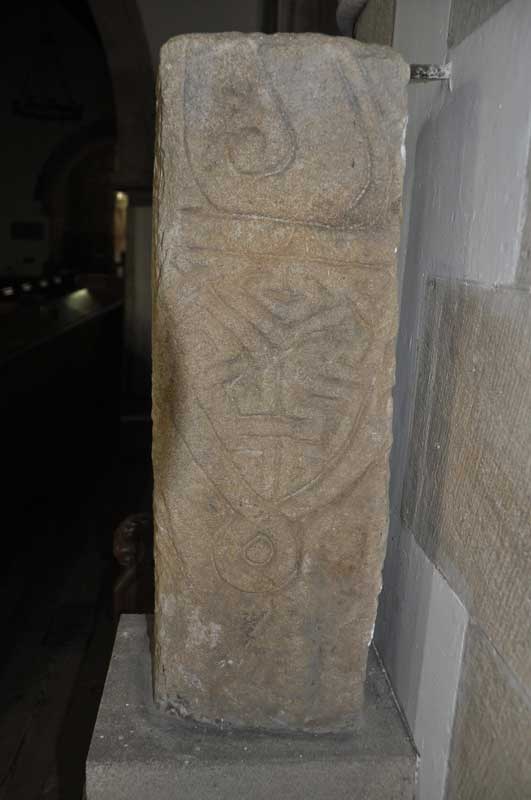
St Andrew's Church (Bywell) submitted by Anne T on 30th Sep 2014. Close up of the second decorated side of the larger fragment, which is the lower part of a cross shaft (Corpus of Anglo-Saxon Stone Sculpture reference: Bywell 01). This face shows the remains of a ring knot and shield shaped pendant.
(View photo, vote or add a comment)
Log Text: Bywell Anglo Saxon Cross (St. Andrew's Church): This is a very pretty spot, nestled in a bend of the River Tyne, surrounded by neatly kept estate lands. The two neighbouring churches on this site are less than 2 miles from my house, but although I've been here on more than one occasion, can't say I've noticed the Anglo Saxon cross in St. Andrew's.
The grid reference on the Anglo-Saxon Corpus Stone Sculpture web site indicated that the cross shaft was located at St. Peter's rather than in St. Andrew’s, the Churches Conservation Trust church, but instinct told me otherwise. However, I went to check anyway. This is the first time I’ve been able to get into the St. Peter's during the day to look around (outside carol services). I was investigating when I heard the west door rattle, which gave me the creeps. There was another gentleman who was walking from Ovingham and wanted to come and look, so we exchanged a few courtesies as we walked around.
What I hadn’t realised was that there were some interesting grave covers with crosses built into the porch of the church.
I couldn’t find the cross shaft, so set off to St. Andrew’s where I saw the stone as soon as I walked through the door.
St Andrews, Bywell Grid reference: NZ 04837 61485
The prettiness of the church, with its unique Saxon tower, never fails to hit me every time I come here. I always remember a good friend's reaction to this when we stopped off here on the way to our presentation at Aykley Heads ("makes me want to get my walking boots on").
The cross shaft is located to the north side of chancel, between the choir stalls and the altar.
St Peter (Osmotherly)
Date Added: 29th Sep 2014
Site Type: Ancient Cross
Country: England (Yorkshire (North))
Visited: Yes on 26th Sep 2014. My rating: Condition 3 Ambience 4 Access 5
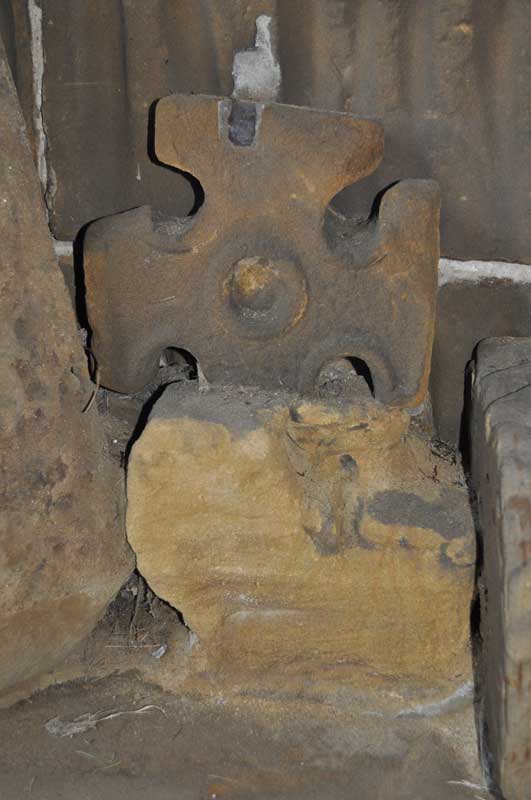
St Peter (Osmotherly) submitted by Anne T on 29th Sep 2014. I was really interested in this Saxon cross head fragment. It is amongst the group on the bench on the western wall of the porch.
(View photo, vote or add a comment)
Log Text: St Peter’s Church, Osmotherley. Saxon cross fragments: Note, whilst there is parking on School Lane immediately by the church, there are steps to negotiate from the road up to the church.
Having failed to get to Mount Grace Priory and St. John’s Well from the northern carriageway of the A19 (there is only access from the southbound carriageway), we went into Osmotherley as I’d seen St. Peter’s and their Saxon cross fragments on the Portal.
St. Peter’s really was ‘the disappearing church’ – coming down North End, it towered over the houses but as we turned to go up West End and got closer to it, it disappeared and we lost our bearings. After two attempts of driving up and down, we turned down School Lane (not Church Lane, as we might have expected!), which, whilst narrow there is parking.
The cross shaft fragments are in the porch of the church, which is open to the weather, so available to visit anytime.
As I was making my way up the steps towards the church porch, there were some ladies coming slowly down the steps towards us. The first lady told us they had just had a choir practice for Harvest Festival, and if I was quick, I could look round the inside of the church.
This church has a lovely atmosphere, and I’d like to go back and have a more leisurely look. The ladies told me that the south nave is Victorian, so the Norman porch must have been moved when this was built.
I saw the cross fragments and photographed them, with the kind ladies surrounding me – all lovely and really interested. They told me about other crosses at Sockburn and St Wilfrid’s Parish Church in South Kilvington to add to my list of places of ‘must see’ sites.
Pudding Pie Hill
Date Added: 29th Sep 2014
Site Type: Round Barrow(s)
Country: England (Yorkshire (North))
Visited: Yes on 26th Sep 2014. My rating: Condition 3 Ambience 4 Access 4
Pudding Pie Hill submitted by rogerkread on 11th Sep 2014. The large mound of Pudding Pie Hill.
(View photo, vote or add a comment)
Log Text: Pudding Pie Hill, Sowerby near Thirsk: From St Mary The Virgin at Leake, we headed south to Thirsk, leaving the A19 at its junction with the A168 to get as close as we could to Pudding Pie Hill.
It wasn’t possible to get to the round barrow from this direction, as there are all private roads leading to houses and small holdings, so we tried driving back into Thirsk and back round to Sowerby.
I always like coming to Thirsk, but never been to Sowerby, and it’s a really quaint little village. Blakey Bridge was closed to traffic so we walked across, through the field with Cod Beck to our right hand side.
The barrow rises up out of what appears to be the flood plain for the Cod Beck. If it weren’t for the very busy A168 roaring past on the eastern side, this barrow would be in a lovely spot indeed.
There is an information board by the footpath leading up to the barrow which explains something of the history and has old photographs of children on the barrow.
We walked up to the top of the mound, and there is indeed a hollow where they excavated it in the nineteenth century.
The ditch around the mound can be seen to its eastern and southern sides. Definitely worth coming to visit briefly.
Howe Hill (Felixkirk)
Date Added: 29th Sep 2014
Site Type: Round Barrow(s)
Country: England (Yorkshire (North))
Visited: Yes on 26th Sep 2014. My rating: Condition 2 Ambience 4 Access 5
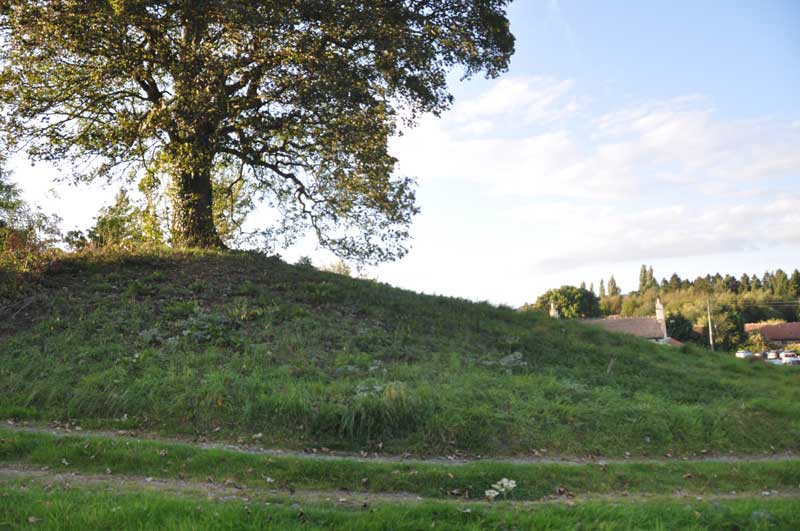
Howe Hill (Felixkirk) submitted by Anne T on 29th Sep 2014. Standing between the minor roads (leading north and north east from the base of the mound) and the metalled driveway, looking back towards the Carpenters Arms (the church is just off shot to the top right hand side).
(View photo, vote or add a comment)
Log Text: Howe Hill Round Barrow, Felixkirk: After having been to Pudding Pie Hill Round Barrow in Sowerby, we drove to the village of Felixkirk from the A170, up the first minor road leading north east. There is no doubt that Howe Hill is something ancient – but what? My initial impression, driving up the hill into the village was that it was a motte, but then it’s too small for a castle.
Howe Hill is immediately opposite the Carpenter’s Arms public house, which has a large car park, and the Howe Hill mound rises up above you. As it is topped by a very large tree, the mound seems to dominate everything around it (in a nice sort of way).
It is possible to sit outside the pub to have a meal and a drink and admire Howe Hill. It being now early evening and getting chilly, we sat inside and had a drink, looking out onto the mound, waiting for the angle of the sun to dip below the mound so I could get some photographs.
However – the monument has sort of been developed around in a somewhat insensitive manner - someone’s driveway (the Old Vicarage? Now up for sale) up its left hand side (facing from the pub), also someone has used the southern side of the mound to burn old tree trunks, which has left a mess. There’s also a road junction with numerous signposts to the northern end of the barrow and the right hand side been landscaped into edge of someone’s drive, but it is still recognisable as an ancient site.
The English Heritage record (not to be confused with How Hill, west of Richmond, North Yorkshire) says that this is a bowl barrow, dating from the Late Neolithic to the Late Bronze Age.
St Felix Church is only a short distance away (different web sites vary between 130 and 200 yards!). Apart from the sheep keeping the grass short in the church yard (this did keep the graveyard looking very neat) and the remains of the Norman windows in the chancel, this church had been extensively modernised, and I was disappointed.
In my opinion, Howe Hill is only worth stopping to look at if you are passing by. Sorry!
St Mary (Leake)
Date Added: 29th Sep 2014
Site Type: Ancient Cross
Country: England (Yorkshire (North))
Visited: Yes on 26th Sep 2014. My rating: Condition 3 Ambience 4 Access 5

St Mary (Leake) submitted by Anne T on 29th Sep 2014. St. Mary The Virgin, Leake, taken from the churchyard wall nearest the A19, looking back at the west end of the Norman tower.
The Saxon cross can just be seen in the centre of the image, just above the window arch.
(View photo, vote or add a comment)
Log Text: St Mary’s Church, Leake: Saxon Cross and Sundial: I hate the A19 as I think it’s a fast, dangerous road, and avoid it whenever I can. However, driving up and down to York in a previous life, I’ve seen this church which is right by the A19 a couple of times before – driving past at 70 mph there is barely time to acknowledge that ‘that church looks interesting’ before you’ve past it.
Not wanting to turn up and find the church closed, I’d checked with the vicar’s wife before setting off (the church is usually left open during the day - “just push the bird screen and close it behind you”).
Having picked husband Andrew up from Northallerton station, we took the road westwards through Bullamoor and Kirkby Sigston back to the A19. Taking our life in our hands, we eventually crossed the road. Looking very carefully for the turnoff to Leake Hall (owned by major farmer G.E. Peacock), the side road was easier to find than we thought, and we pulled up outside the church. There is surprisingly a large car park for the congregation, which is wonderfully well cared for – this church has a very friendly atmosphere.
The skies were brilliant blue, which made taking photographs interesting – lots of light and dark shadows.
The first amazing thing about this church was the door, which is obviously very old with a smaller door set inside it (and internally, its lock).
It is easy to spot the Saxon cross on the west wall of the tower. The church guide says that this may well have been the original churchyard cross.
It was a little harder to make out the sundial, which is on the south wall of the nave, just east of the porch, as I was expecting a ‘scratch cross’. It can be found next to a medieval roundel, and is just a plain base with the remnants of an iron post in the centre. The medieval roundel is splendid, with a carved beast prominent.
Internally, the building has some really interesting features – the Norman pillars with their carved capitals; the bend in the arch above the west door, and also the carvings on the bench-ends from the 1500s (which came from Bridlington Priory following the Dissolution).
The farm (Leake Hall) next door is really old, and it would have been nice to have been able to wander round this, too.
Definitely worth a stop if passing by.
Goatstones O
Date Added: 23rd Sep 2014
Site Type: Rock Art
Country: England (Northumberland)
Visited: Yes on 21st Sep 2014. My rating: Condition 3 Ambience 3 Access 3
Goatstones O submitted by SolarMegalith on 10th Jul 2013. General view of Goatstones O panel (photo taken on June 2013).
(View photo, vote or add a comment)
Log Text: Goatstones O, Simonburn, Northumberland: See visit report for Goatstones A (14 rock art stones/boulders within a couple of hundred metres).
Goatstones N
Date Added: 23rd Sep 2014
Site Type: Rock Art
Country: England (Northumberland)
Visited: Yes on 21st Sep 2014. My rating: Condition 3 Ambience 3 Access 3
Goatstones N submitted by SolarMegalith on 10th Jul 2013. Close-up of the cup-mark on Goatstones N (photo taken on June 2013).
(View photo, vote or add a comment)
Log Text: Goatstones N, Simonburn, Northumberland: See visit report for Goatstones A (14 rock art boulders all within a couple of hundred metres)
Goatstones J
Date Added: 23rd Sep 2014
Site Type: Rock Art
Country: England (Northumberland)
Visited: Yes on 21st Sep 2014. My rating: Condition 4 Ambience 4 Access 3
Goatstones J submitted by SolarMegalith on 7th Jul 2013. This decorated portable bears a single cup-mark (photo taken on June 2013).
(View photo, vote or add a comment)
Log Text: Goatstones J, Simonburn, Northumberland: This was a real treat - a marker stone on top of an apparently undisturbed cairn. For rest of visit report, see Goatstones A (14 rock art boulders within a couple of hundred metres).
Goatstones F.
Date Added: 23rd Sep 2014
Site Type: Rock Art
Country: England (Northumberland)
Visited: Yes on 21st Sep 2014. My rating: Condition 3 Ambience 3 Access 3
Goatstones F. submitted by SolarMegalith on 5th Jul 2013. Cup-marks near the top of Goatstones F boulder (photo taken on June 2013).
(View photo, vote or add a comment)
Log Text: Goatstones F, Simonburn, Northumberland: See visit report for Goatstones A (14 rock art stones with a couple of hundred yards of each other).
Goatstones G
Date Added: 23rd Sep 2014
Site Type: Rock Art
Country: England (Northumberland)
Visited: Yes on 21st Sep 2014. My rating: Condition 3 Ambience 3 Access 3
Goatstones G submitted by SolarMegalith on 7th Jul 2013. Possible cup-marks which might be erosion features (photo taken on June 2013).
(View photo, vote or add a comment)
Log Text: Goatstones G, Simonburn, Northumberland: See visit report for Goatstones A (14 rock art boulders within a couple of hundred metres)
Goatstones E
Date Added: 23rd Sep 2014
Site Type: Rock Art
Country: England (Northumberland)
Visited: Yes on 21st Sep 2014. My rating: Condition 3 Ambience 3 Access 3
Goatstones E submitted by SolarMegalith on 5th Jul 2013. Close-up of the cup-mark (photo taken on June 2013).
(View photo, vote or add a comment)
Log Text: Goatstones E, Simonburn, Northumberland: See visit report for Goatstones A (14 rock art stones within a couple of hundred yards).
